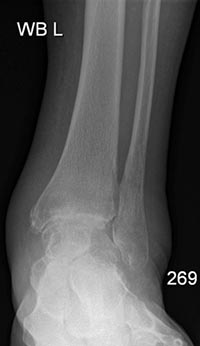 What is ankle arthritis?
What is ankle arthritis?
Arthritis is essentially cartilage failure; the failure of the cartilage leads to pain.
Why does it develop?
Most cases of ankle arthritis develop in patients who have had a significant injury to their ankle in the past, the ankle, either a bad ’sprain’ or a fracture (break).
Malalignment of the foot or ankle can lead to abnormal stresses passing through the ankle, which can lead to arthritis. In some cases there may be a genetic tendency (inherited) to develop it. Finally in other cases there may be no obvious cause.
What symptoms does it cause?
Pain: initially this may be when the ankle is bent upwards i.e. when walking up or down hills and stairs, later on it can occur with any movement, but worse with weight bearing. When the arthritis is severe it can occur at rest and at night. The pain may also lead to a sensation of instability. If there is a loose flap of cartilage this can cause a catching sensation.
Stiffness: As part of the process of arthritis development extra bone (osteophytes) forms on the bones on either side of the joint, which then restrict the movement of the joint.
What options are there for treatment?
a. Pain relieving medication
Various pain-relieving medications are available either over the counter or on prescription from your doctor.
b. Braces/ splints
These may help to reduce the movement in the ankle and this in turn can help reduce the pain. Some of these are available from high street shops, however the more effective ones need to be made by orthotists. If a specific splint is required the exact type can be assessed by the consultant that you see in the clinic who can then refer you on to an orthotist for it to be made.
c. Injections
These may help in the short term.
d. Surgery
There are various different options, the main three are briefly outlined below:
i. Arthroscopic debridement
If the pain is due to catching or when the ankle bends upwards then the areas causing these problems can de removed using keyhole (arthroscopic) techniques.See: Ankle Arthroscopy.
ii. Ankle fusion
If the arthritis is more advanced then ankle fusion is the most traditional treatment. The joint is stiffened and held together with screws (or screws and plate). This creates a pain free stiff joint, fortunately the two joints in front of the ankle provide approximately 30% of the up and down movement of the ’ankle region’ and therefore when the ankle has been fused, there will still be some up and down movement, but it will not be normal.
This can often now be performed using keyhole technique.See: Ankle Fusion: Arthroscopic.
If the alignment of the ankle is significantly abnormal then the fusion will have to be undertaken using the open technique. See: Ankle Fusion: Open.
iii. Ankle Replacement
If the arthritis is advanced, in some cases an ankle replacement may be the most appropriate treatment. See: Ankle Replacement.
Your specialist will discuss the most appropriate treatment with you.
